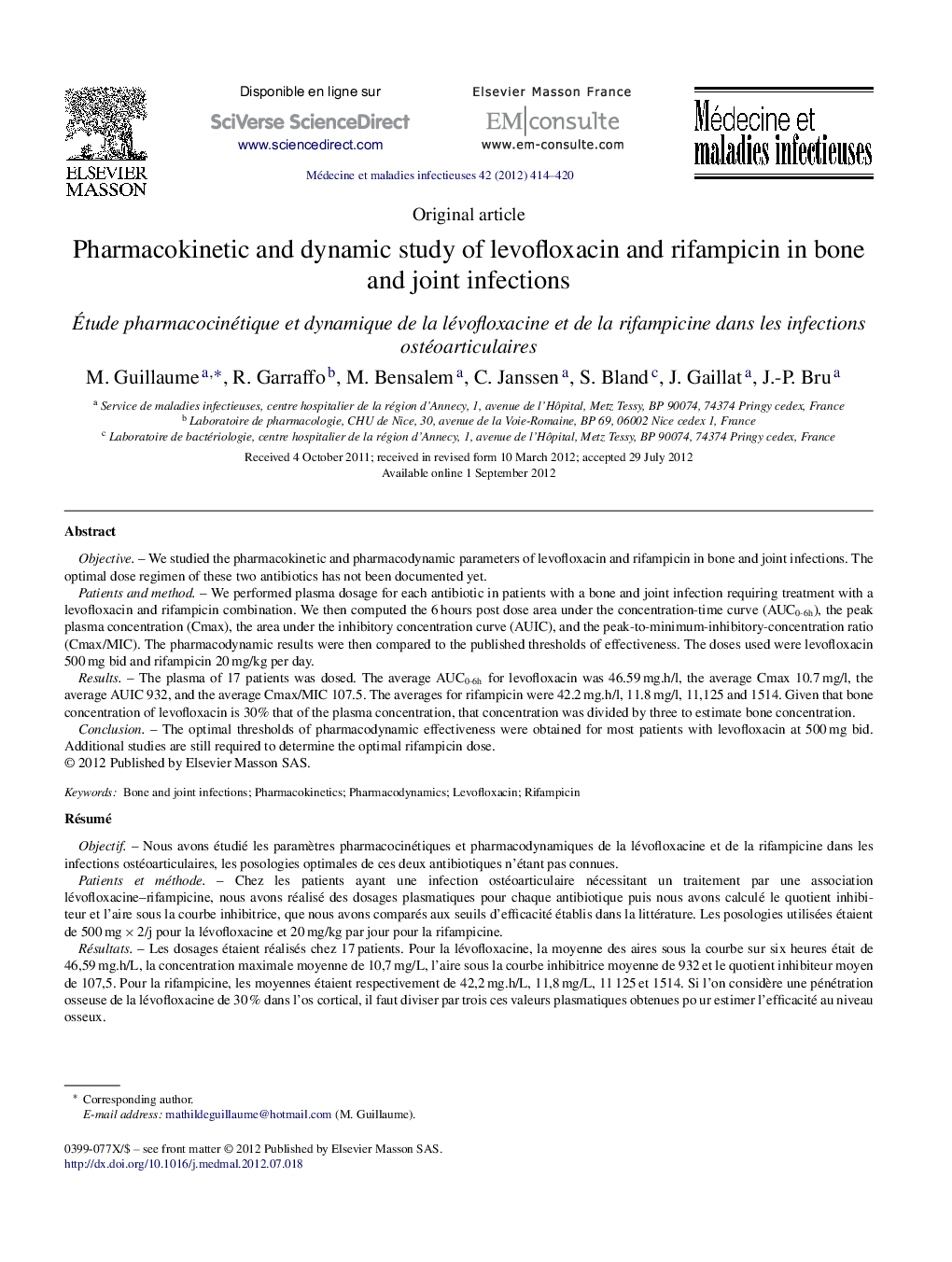| کد مقاله | کد نشریه | سال انتشار | مقاله انگلیسی | نسخه تمام متن |
|---|---|---|---|---|
| 3413041 | 1224263 | 2012 | 7 صفحه PDF | دانلود رایگان |

ObjectiveWe studied the pharmacokinetic and pharmacodynamic parameters of levofloxacin and rifampicin in bone and joint infections. The optimal dose regimen of these two antibiotics has not been documented yet.Patients and methodWe performed plasma dosage for each antibiotic in patients with a bone and joint infection requiring treatment with a levofloxacin and rifampicin combination. We then computed the 6 hours post dose area under the concentration-time curve (AUC0-6h), the peak plasma concentration (Cmax), the area under the inhibitory concentration curve (AUIC), and the peak-to-minimum-inhibitory-concentration ratio (Cmax/MIC). The pharmacodynamic results were then compared to the published thresholds of effectiveness. The doses used were levofloxacin 500 mg bid and rifampicin 20 mg/kg per day.ResultsThe plasma of 17 patients was dosed. The average AUC0-6h for levofloxacin was 46.59 mg.h/l, the average Cmax 10.7 mg/l, the average AUIC 932, and the average Cmax/MIC 107.5. The averages for rifampicin were 42.2 mg.h/l, 11.8 mg/l, 11,125 and 1514. Given that bone concentration of levofloxacin is 30% that of the plasma concentration, that concentration was divided by three to estimate bone concentration.ConclusionThe optimal thresholds of pharmacodynamic effectiveness were obtained for most patients with levofloxacin at 500 mg bid. Additional studies are still required to determine the optimal rifampicin dose.
RésuméObjectifNous avons étudié les paramètres pharmacocinétiques et pharmacodynamiques de la lévofloxacine et de la rifampicine dans les infections ostéoarticulaires, les posologies optimales de ces deux antibiotiques n’étant pas connues.Patients et méthodeChez les patients ayant une infection ostéoarticulaire nécessitant un traitement par une association lévofloxacine–rifampicine, nous avons réalisé des dosages plasmatiques pour chaque antibiotique puis nous avons calculé le quotient inhibiteur et l’aire sous la courbe inhibitrice, que nous avons comparés aux seuils d’efficacité établis dans la littérature. Les posologies utilisées étaient de 500 mg × 2/j pour la lévofloxacine et 20 mg/kg par jour pour la rifampicine.RésultatsLes dosages étaient réalisés chez 17 patients. Pour la lévofloxacine, la moyenne des aires sous la courbe sur six heures était de 46,59 mg.h/L, la concentration maximale moyenne de 10,7 mg/L, l’aire sous la courbe inhibitrice moyenne de 932 et le quotient inhibiteur moyen de 107,5. Pour la rifampicine, les moyennes étaient respectivement de 42,2 mg.h/L, 11,8 mg/L, 11 125 et 1514. Si l’on considère une pénétration osseuse de la lévofloxacine de 30 % dans l’os cortical, il faut diviser par trois ces valeurs plasmatiques obtenues pour estimer l’efficacité au niveau osseux.ConclusionsAvec une posologie de lévofloxacine de 500 mg × 2/j, les seuils d’efficacité pharmacodynamiques sont atteints pour la majorité des patients mais pas pour tous. Des études complémentaires sont nécessaires pour déterminer des seuils d’efficacité pour la rifampicine.
Journal: Médecine et Maladies Infectieuses - Volume 42, Issue 9, September 2012, Pages 414–420